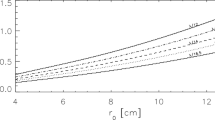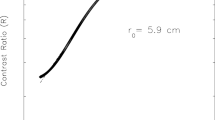Abstract
Ground-based observations suffer from atmospheric turbulence perturbations, which seriously degrade the image quality. The seeing profile associated with the turbulence is critical to characterize an astronomical site. The optimal design and performance estimation of future solar ground-layer adaptive optics (GLAO) and multi-conjugate adaptive optics (MCAO) heavily rely on our knowledge of the seeing profile at a specific site. Many current optical seeing profile measurement techniques require one to use a large solar telescope for that purpose. The development of a portable instrument to measure and characterize the seeing profile is thus highly needed, in particular for testing potential new sites or for the regularly monitoring of the seeing condition at existing sites. Recently, we proposed the Advanced Multiple Aperture Seeing Profiler (A-MASP), which uses multiple small telescopes and multiple regions of interest (ROIs) on the solar surface to measure the seeing profile up to an altitude of 30 km. Here, we report our recent proof-of-concept observation run of the A-MASP technique with the Dunn Solar Telescope (DST) of the National Solar Observatory (NSO). We found that the Fried parameter, \(r_{0}\), was about 12 cm at the observed wavelength of 630 nm in the early morning and that there were three main turbulence layers. The strongest one was the mix layer near the ground. We observed the evolution of the top of the mix layer and found that it can rise to about 1.5 km in about 18 min, which is consistent with the theory of daytime boundary layer evolution. Another turbulence layer was observed from 8 to 15 km, which is at the top of the convective layer. Comparing an instrument with two sub-apertures with a real A-MASP instrument, we found that they should lead to similar results except for the altitude \(h = 0\).









Similar content being viewed by others
References
Avila, R., Avilés, J.L., Wilson, R.W., Chun, M., Butterley, T., Carrasco, E.: 2008, Mon. Not. Roy. Astron. Soc. 387, 1511. DOI .
Beckers, J.M.: 1988, Very Large Telescopes and Their Instrumentation, 2, 693.
Beckers, J.M.: 2001, Exp. Astron. 12, 1.
Beckers, J., Brown, T., Collados, M., Denker, C., Hill, F., Kuhn, J., et al.: 2004, RPT-0021 Site Survey Working Group Final Report.
Benoit, N., Thierry, F., Jean-Marc, C.: 2009, J. Opt. Soc. Am. A 26(1), 219. DOI .
Berkefeld, T., Soltau, D., Schmidt, D., von der Lühe, O.: 2010, Appl. Opt. 49(31), G155. DOI .
Butterley, T., Wilson, R.W., Sarazin, M.: 2006, Mon. Not. Roy. Astron. Soc. 369, 835. DOI .
Collados, M., Bettonvil, F., Cavaller, L., Ermolli, I., Gelly, B., Grivel-Gelly, C., Pérez, A., Socas-Navarro, H., Soltau, D., Volkmer, R.: 2010, Proc. SPIE 7733, 77330H. DOI .
Egner, S.E., Masciadri, E.: 2007, Publ. Astron. Soc. Pac. 119, 1441. DOI .
Elmore, D.F., Rimmele, T., Casini, R., Hegwer, S., Kuhn, J., Lin, H., McMullin, J.P., Reardon, K., Schmidt, W., Tritschler, A., Wöger, F.: 2014, Proc. SPIE 9147, 914707. DOI .
Els, S.G., Schöck, M., Riddle, R., Skidmore, W., Travouillon, T.: 2009, Optical Turbulence: Astronomy Meets Meteorology, 224. DOI .
Hill, F., Collados, M.: 2003, Bull. Am. Astron. Soc. 35, 848.
Kellerer, A., Gorceix, N., Marino, J., Cao, W., Goode, P.R.: 2012, Astron. Astrophys. 542, A2. DOI .
Kellerer, A.: 2015, ArXiv e-prints, arXiv .
Löfdahl, M.G.: 2010, Astron. Astrophys. 524, A90. DOI .
Ren, D., Jolissaint, L., Zhang, X., Dou, J., Chen, R., Zhao, G., Zhu, Y.: 2015, Publ. Astron. Soc. Pac. 127, 469. DOI .
Ren, D., Zhao, G.: 2016, Publ. Astron. Soc. Pac. 128, 105002. DOI .
Ren, D., Zhu, Y., Zhang, X., Dou, J., Zhao, G.: 2014, Appl. Opt. 53, 1683. DOI .
Ricort, G., Aime, C., Roddier, C., Borgnino, J.: 1981, Solar Phys. 69, 223. DOI .
Ricort, G., Borgnino, J., Aime, C.: 1982, Solar Phys. 75, 377. DOI .
Rimmele, T.R., Radick, R.R.: 1998, P. Soc. Photo.-Opt. Ins. 3353, 72.
Rimmele, T.R., Woeger, F., Marino, J., Richards, K., Hegwer, S., Berkefeld, T., Soltau, D., Schmidt, D., Waldmann, T.: 2010, P. Soc. Photo.-Opt. Ins. 7736, 773631.
Rimmele, T.R., Marino, J.: 2011, Living Rev. Solar Phys. 8, 2. DOI .
Sarazin, M., Roddier, F.: 1990, Astron. Astrophys. 227, 294.
Scharmer, G.B., van Werkhoven, T.I.M.: 2010, Astron. Astrophys. 513, A25. DOI .
Stull, R.B.: 1988, Atmospheric Sciences Library, Kluwer, Dordrecht.
Tokovinin, A., Kornilov, V., Shatsky, N., Voziakova, O.: 2003, Mon. Not. Roy. Astron. Soc. 343, 891. DOI .
Tokovinin, A.: 2004, Publ. Astron. Soc. Pac. 116, 941. DOI .
Townson, M.J., Kellerer, A., Osborn, J., Butterley, T., Morris, T., Wilson, R.W.: 2014, Proc. SPIE 9147, 91473E. DOI .
Vernin, J., Munoz-Tunon, C.: 1994, Astron. Astrophys. 284, 311.
Wilson, R.W.: 2002, Mon. Not. Roy. Astron. Soc. 337, 103. DOI .
Acknowledgements
This work is being supported by National Science Foundation (NSF) under the grant AST-1607921. Our system was tested with the National Science Foundation’s Dunn Solar Telescope at Sacramento Peak operated by the National Solar Observatory. The National Solar Observatory is operated by the Association of Universities for Research in Astronomy under a cooperative agreement with the National Science Foundation for the benefit of the astronomical community. We thank the anonymous referee for valuable and thoughtful comments, which significantly improved this publication.
Author information
Authors and Affiliations
Corresponding author
Ethics declarations
Disclosure of Potential Conflict of Interest
The authors declare that they have no conflict of interest.
Rights and permissions
About this article
Cite this article
Ren, D., Zhao, G., Wang, X. et al. The First Solar Seeing Profile Measurement with Two Apertures and Multiple Guide Regions. Sol Phys 294, 1 (2019). https://doi.org/10.1007/s11207-018-1389-z
Received:
Accepted:
Published:
DOI: https://doi.org/10.1007/s11207-018-1389-z




